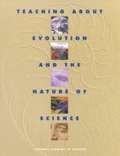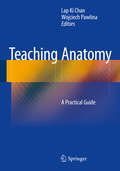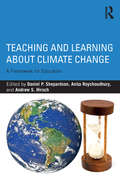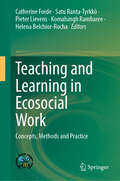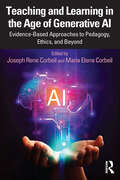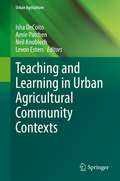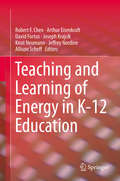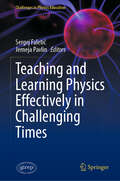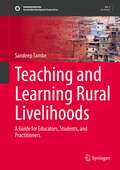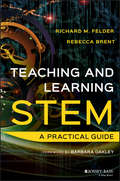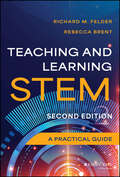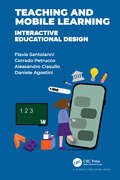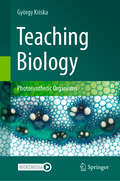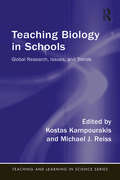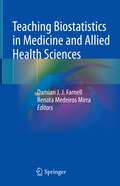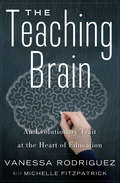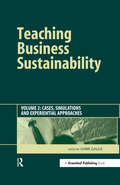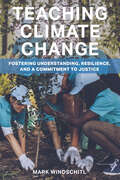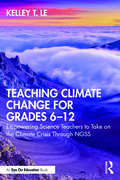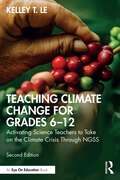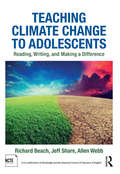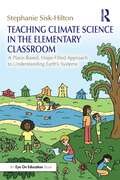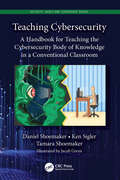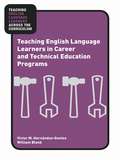- Table View
- List View
Teaching About Evolution And The Nature Of Science
by National Academy of Sciences Staff Joyce L. Vedral Working Group on Teaching EvolutionToday many school students are shielded from one of the most important concepts in modern science: evolution. In engaging and conversational style, Teaching About Evolution and the Nature of Science provides a well-structured framework for understanding and teaching evolution.Written for teachers, parents, and community officials as well as scientists and educators, this book describes how evolution reveals both the great diversity and similarity among the Earth's organisms; it explores how scientists approach the question of evolution; and it illustrates the nature of science as a way of knowing about the natural world. In addition, the book provides answers to frequently asked questions to help readers understand many of the issues and misconceptions about evolution.The book includes sample activities for teaching about evolution and the nature of science. For example, the book includes activities that investigate fossil footprints and population growth that teachers of science can use to introduce principles of evolution. Background information, materials, and step-by-step presentations are provided for each activity. In addition, this volume:-- Presents the evidence for evolution, including how evolution can be observed today.-- Explains the nature of science through a variety of examples.-- Describes how science differs from other human endeavors and why evolution is one of the best avenues for helping students understand this distinction.-- Answers frequently asked questions about evolution.Teaching About Evolution and the Nature of Science builds on the 1996 National Science Education Standards released by the National Research Council--and offers detailed guidance on how to evaluate and choose instructional materials that support the standards.Comprehensive and practical, this book brings one of today's educational challenges into focus in a balanced and reasoned discussion. It will be of special interest to teachers of science, school administrators, and interested members of the community.
Teaching Anatomy
by Lap Ki Chan Wojciech PawlinaTeaching Anatomy: A Practical Guide is the first book designed to provide highly practical advice to both novice and experienced gross anatomy teachers. The volume provides a theoretical foundation of adult learning and basic anatomy education and includes chapters focusing on specific issues that teachers commonly encounter in the diverse and challenging scenarios in which they teach. The book is designed to allow teachers to adopt a student-centered approach and to be able to give their students an effective and efficient overall learning experience. Teachers of gross anatomy and other basic sciences in undergraduate healthcare programs will find in this unique volume invaluable information presented in a problem-oriented, succinct, and user-friendly format. Developed by renowned, expert authors, the chapters are written concisely and in simple language, and a wealth of text boxes are provided to bring out key points, to stimulate reflection on the reader's own situation, and to provide additional practical tips. Educational theories are selectively included to explain the theoretical foundation underlying practical suggestions, so that teachers can appropriately modify the strategies described in the book to fit their own educational environments. Comprehensive and a significant contribution to the literature, Teaching Anatomy: A Practical Guide is an indispensable resource for all instructors in gross anatomy.
Teaching and Learning about Climate Change: A Framework for Educators
by Daniel P. Shepardson, Anita Roychoudhury and Andrew S. HirschResponding to the issues and challenges of teaching and learning about climate change from a science education-based perspective, this book is designed to serve as an aid for educators as they strive to incorporate the topic into their classes. The unique discussion of these issues is drawn from the perspectives of leading and international scholars in the field. The book is structured around three themes: theoretical, philosophical, and conceptual frameworks for climate change education and research; research on teaching and learning about global warming and climate change; and approaches to professional development and classroom practice.
Teaching and Learning in Ecosocial Work: Concepts, Methods and Practice
by Catherine Forde Satu Ranta-Tyrkkö Pieter Lievens Komalsingh Rambaree Helena Belchior-RochaThis book aims to champion teaching and learning of ecosocial work in educational institutions which offer social work and related programmes. It is the first book to focus specifically on teaching and learning in ecosocial work and one of the first to incorporate student perspectives on and initiatives in ecosocial work teaching, learning and practice. Ecosocial work is an evolving framework to learn about and practice social work from the premise that humans are part of the web of life on Earth. While this understanding should guide human activities, current planetary-scale anthropogenic socio-environmental problems such as the climate crisis, ocean acidification, biodiversity and species loss, prove the opposite. Social work and allied professions stem from the same anthropocentric world view and need to reconfigure their relationship to other-than-humans and the planetary limits of existence. This requires in-depth renewal of social work and related professions and an ecosocial/ecological paradigm change in which education is pivotal. Written by academics, students and practitioners working in different parts of the world and offering interdisciplinary perspectives, the book provides: Chapters and case studies on concepts, methods, and experiences of teaching and learning in ecosocial work. Discussion of the current terrain of ecosocial work in principle and practice. Ideas on the kinds of new thinking ecosocial work requires and on how these can be taught and practiced, promoting economic, social and environmental sustainability. This book makes an original and internationally acclaimed contribution to ecosocial work education. As the conduit for preparing social workers to become active agents of ecosocial change, critical attention is given to the importance of education as foundational to this professional endeavour. This book provides essential reading for all social work professionals, scholars, educators, and learning institutions. Heather Boetto, Associate Professor, Charles Stuart University, Australia. A comprehensive book about the challenges and opportunities of teaching the ecosocial framework in social work. Various perspectives open up new possibilities for understanding the practices of teaching ecosocial work in different contexts. A strong reading recommendation for anyone interested in understanding and teaching the relationship between social work and environmental issues. Kati Närhi, Professor, University of Jyväskylä, Finland.
Teaching and Learning in the Age of Generative AI: Evidence-Based Approaches to Pedagogy, Ethics, and Beyond
by Joseph Rene Corbeil Maria Elena CorbeilTeaching and Learning in the Age of Generative AI explores how educators can effectively harness the potential of artificial intelligence technologies while skillfully navigating its pedagogical, technical, ethical, institutional, and societal implications. The increasing accessibility of AI technologies among K-12 and higher education students has raised extensive concerns around academic integrity, though a deeper lineage of research and development suggests that these tools may be used to supplement instruction, prioritize critical thinking, and promote digital literacy. Bookended by in-depth analyses of the historical and future trajectories of artificial intelligence in education, this comprehensive resource provides evidence-based strategies for classroom implementation and helpful summaries of common benefits and risks. Teaching assistance, personalized learning, redefined assessments, anti-bias measures, and safeguards against misconduct and privacy infringement are among the wealth of topics addressed in these chapters. This book is an ideal text for undergraduate and graduate students of teacher education and curriculum and instruction as well as for higher education teaching faculty, school technology coordinators, and talent development personnel in training and in service.
Teaching and Learning in Urban Agricultural Community Contexts (Urban Agriculture)
by Isha DeCoito Amie Patchen Neil Knobloch Levon EstersThis book fills a void in the literature around how urban agricultural education can be used to create opportunities to educate youth and citizens who live in urban areas about growing food. To date, very little has been written about program design and the impact of such experiences on learning outcomes. In fact, most of the journal articles and research to date has focused on access, contextual factors, sustainability, relevance of urban agricultural education, and the intersection of science of agriculture. This book will cover such topics as how urban youth learn science while engaged in urban agriculture programs, how such programs support youth in becoming interested about healthy eating and science more generally, and how to design urban agriculture programs in support of STEM education. The chapters in this book are written by educational researchers and each chapter has been reviewed by researchers and practitioners.
Teaching and Learning of Energy in K - 12 Education
by Robert F. Chen Arthur Eisenkraft David Fortus Joseph Krajcik Knut Neumann Jeffrey Nordine Allison ScheffThis volume presents current thoughts, research, and findings that were presented at a summit focusing on energy as a cross-cutting concept in education, involving scientists, science education researchers and science educators from across the world. The chapters cover four key questions: what should students know about energy, what can we learn from research on teaching and learning about energy, what are the challenges we are currently facing in teaching students this knowledge, and what needs be done to meet these challenges in the future? Energy is one of the most important ideas in all of science and it is useful for predicting and explaining phenomena within every scientific discipline. The challenge for teachers is to respond to recent policies requiring them to teach not only about energy as a disciplinary idea but also about energy as an analytical framework that cuts across disciplines. Teaching energy as a crosscutting concept can equip a new generation of scientists and engineers to think about the latest cross-disciplinary problems, and it requires a new approach to the idea of energy. This book examines the latest challenges of K-12 teaching about energy, including how a comprehensive understanding of energy can be developed. The authors present innovative strategies for learning and teaching about energy, revealing overlapping and diverging views from scientists and science educators. The reader will discover investigations into the learning progression of energy, how understanding of energy can be examined, and proposals for future directions for work in this arena. Science teachers and educators, science education researchers and scientists themselves will all find the discussions and research presented in this book engaging and informative.
Teaching and Learning Physics Effectively in Challenging Times (Challenges in Physics Education)
by Sergej Faletič Jerneja PavlinThis book presents a comprehensive collection of recent developments in Physics Education Research. Expert authors contribute chapters reflecting insights gained from years of experience and recent research advancements. The book begins with general frameworks and guidelines for teaching and learning physics. It then examines experience-based learning, including experiential learning, inquiry-based learning, and remote experimental activities. Further, it addresses the teaching and learning of complex topics such as environmental science and contemporary physics. Finally, it focuses on teacher education, a crucial area for translating research into classroom practice. Together, these chapters provide a comprehensive overview of the latest advancements in teaching and learning physics.
Teaching and Learning Rural Livelihoods: A Guide for Educators, Students, and Practitioners (Sustainable Development Goals Series)
by Sandeep TambeThis book synthesizes the conceptual and applied aspects of rural livelihoods as a discipline, and collates the analytical frameworks and approaches that have been designed, applied, and discussed over the last five decades. These include the sustainable livelihoods approach with its vulnerability-asset construct, collective governance of common pool resources, livelihood trajectories and poverty dynamics, rights-based approach and social justice, graduation approach for the ultra-poor, and the resilience framework to address complex risks. The book is divided into three parts, namely: introduction to rural livelihoods; synthesis of the present state of knowledge; and strengthening the knowledge action pathway. At the end of each chapter, a set of class exercises is provided to bring about a deeper understanding of these approaches and their application in real-life situations.The expected outputs from penning this textbook are threefold. Firstly, it assimilates the rural livelihood works of eminent academicians under one cover. Secondly, it positions itself as a one-stop destination for educators by translating these concepts into a ready-to-teach applied format. Thirdly, it functions as a ready reckoner for young professionals by providing a step-by-step approach to apply these learnings in real-life situations. The purpose of this book is to provide a solid foundation to the teaching and learning of rural livelihoods in academia, bridge the gap between the science, policy, and practice of rural livelihoods, and finally shape a pool of better informed and equipped professionals in development.Special thanks to Himanshu Rohira for his contributions and assistance.
Teaching and Learning STEM
by Richard M. Felder Rebecca BrentRethink traditional teaching methods to improve student learning and retention in STEM Educational research has repeatedly shown that compared to traditional teacher-centered instruction, certain learner-centered methods lead to improved learning outcomes, greater development of critical high-level skills, and increased retention in science, technology, engineering, and mathematics (STEM) disciplines. Teaching and Learning STEM presents a trove of practical research-based strategies for designing and teaching courses and assessing students' learning. The book draws on the authors' extensive backgrounds and decades of experience in STEM education and faculty development. Its engaging and well-illustrated descriptions will equip you to implement the strategies in your courses and to deal effectively with problems (including student resistance) that might occur in the implementation. The book will help you: Plan and conduct class sessions in which students are actively engaged, no matter how large the class is Make good use of technology in face-to-face, online, and hybrid courses and flipped classrooms Assess how well students are acquiring the knowledge, skills, and conceptual understanding the course is designed to teach Help students develop expert problem-solving skills and skills in communication, creative thinking, critical thinking, high-performance teamwork, and self-directed learning Meet the learning needs of STEM students with a broad diversity of attributes and backgrounds The strategies presented in Teaching and Learning STEM don't require revolutionary time-intensive changes in your teaching, but rather a gradual integration of traditional and new methods. The result will be continual improvement in your teaching and your students' learning.
Teaching and Learning STEM: A Practical Guide
by Richard M. Felder Rebecca BrentThe widely used STEM education book, updated Teaching and Learning STEM: A Practical Guide covers teaching and learning issues unique to teaching in the science, technology, engineering, and math (STEM) disciplines. Secondary and postsecondary instructors in STEM areas need to master specific skills, such as teaching problem-solving, which are not regularly addressed in other teaching and learning books. This book fills the gap, addressing, topics like learning objectives, course design, choosing a text, effective instruction, active learning, teaching with technology, and assessment—all from a STEM perspective. You’ll also gain the knowledge to implement learner-centered instruction, which has been shown to improve learning outcomes across disciplines. For this edition, chapters have been updated to reflect recent cognitive science and empirical educational research findings that inform STEM pedagogy. You’ll also find a new section on actively engaging students in synchronous and asynchronous online courses, and content has been substantially revised to reflect recent developments in instructional technology and online course development and delivery. Plan and deliver lessons that actively engage students—in person or online Assess students’ progress and help ensure retention of all concepts learned Help students develop skills in problem-solving, self-directed learning, critical thinking, teamwork, and communication Meet the learning needs of STEM students with diverse backgrounds and identitiesThe strategies presented in Teaching and Learning STEM don’t require revolutionary time-intensive changes in your teaching, but rather a gradual integration of traditional and new methods. The result will be a marked improvement in your teaching and your students’ learning.
Teaching and Mobile Learning: Interactive Educational Design
by Flavia Santoianni Corrado Petrucco Alessandro Ciasullo Daniele AgostiniTeaching and Mobile Learning: Interactive Educational Design is a groundbreaking book which shows how to design innovative educational mobile learning environments to instructional designers, curriculum developers, and learning professionals. The book aims to solicit teachers, educators, and practitioners to adapt their teaching with the help of educational digital models related to mobile technologies. Mobile learning is a revolution in concepts like space, sound production, and learning to get more and more customized in always-connected and ever-changing educational mobile learning environments. Researchers and academicians can be trained in cognition processes in learning management of mixed reality and virtual bodies. Mixed reality mobile technologies are becoming tools for education and training in mixed reality mobile learning. Readers of this book will understand how user and device innovative interactions are borderline with attention deficit disorder, digital amnesia, and information overload. The book develops educational knowledge on how to manage mobile technology and specific learning disorders to monitor the use of smartphones and technology tools and to empower their role in learning enhancement processes.
Teaching Biology: Photosynthetic Organisms
by György KriskaThe primary aim of the book entitled "Teaching biology - Photosynthetic Organisms" is to support practice-oriented teaching of biology, therefore it includes detailed descriptions of illustrated investigations and experiments alongside basic theoretical knowledge. In line with contemporary requirements, these are complemented by digital aids, such as interactive test exercises. This makes the book a useful tool for not only making observations and carrying out experiments, but also for classroom activities and independent learning. The wide range of exercises can provide a good basis for preparing for competitions and for activities that focus on the independent research work of students. In addition to the simple observations presented in the book, the laboratory exercises are not very time-consuming either and they do not require special materials or equipment. The investigations can be carried out in a school with average equipment.
Teaching Biology in Schools: Global Research, Issues, and Trends (Teaching and Learning in Science Series)
by Kostas Kampourakis Michael J. ReissAn indispensable tool for biology teacher educators, researchers, graduate students, and practising teachers, this book presents up-to-date research, addresses common misconceptions, and discusses the pedagogical content knowledge necessary for effective teaching of key topics in biology. Chapters cover core subjects such as molecular biology, genetics, ecology, and biotechnology, and tackle broader issues that cut across topics, such as learning environments, worldviews, and the nature of scientific inquiry and explanation. Written by leading experts on their respective topics from a range of countries across the world, this international book transcends national curricula and highlights global issues, problems, and trends in biology literacy.
Teaching Biostatistics in Medicine and Allied Health Sciences
by Damian J. J. Farnell Renata Medeiros MirraThis book discusses the theory and practice of teaching biostatistics to students in the life sciences, in particular medical and dental trainees and researchers, as well as its crucial importance to biomedical research and evidence-based health care. Specific tools and resources to biostatistics teaching (e.g., “R shiny”) are described, and how they can be used effectively to increase interaction with students and improve engagement with the subject. The book is structured into three parts: teaching and learning of statistics in medicine and allied health sciences; the move to online learning and online learning methods, especially in light of the impact of COVID-19; and computer tools and resources. It provides a unique insight into teaching biostatistics to medical and dental students from some of the most prominent biostatisticians who also have a very strong interest in biostatistics pedagogy. Biostatistics teaching is important for maintaining the quality of biomedical research and also in evidence-based medicine, both of which are key to the health and well-being of the world population. This book is particularly useful to readers who are new to the field of biostatistics teaching as well as to more experienced teachers as it presents the latest accounts of the teaching and learning of biostatistics, recent experiences of increased use of online teaching, and useful computer resources and tools for teaching biostatistics.
The Teaching Brain: An Evolutionary Trait at the Heart of Education
by Vanessa Rodriguez Michelle Fitzpatrick&“A significant contribution to understanding the interaction among teachers, students, the environment, and the content of learning&” (Herbert Kohl, education advocate and author). What is at work in the mind of a five-year-old explaining the game of tag to a new friend? What is going on in the head of a thirty-five-year-old parent showing a first-grader how to button a coat? And what exactly is happening in the brain of a sixty-five-year-old professor discussing statistics with a room full of graduate students? While research about the nature and science of learning abounds, shockingly few insights into how and why humans teach have emerged—until now. Countering the dated yet widely held presumption that teaching is simply the transfer of knowledge from one person to another, The Teaching Brain weaves together scientific research and real-life examples to show that teaching is a dynamic interaction and an evolutionary cognitive skill that develops from birth to adulthood. With engaging, accessible prose, Harvard researcher Vanessa Rodriguez reveals what it actually takes to become an expert teacher. At a time when all sides of the teaching debate tirelessly seek to define good teaching—or even how to build a better teacher—The Teaching Brain upends the misguided premises for how we measure the success of teachers. &“A thoughtful analysis of current educational paradigms . . . Rodriguez&’s case for altering pedagogy to match the fluctuating dynamic forces in the classroom is both convincing and steeped in common sense.&” —Publishers Weekly
Teaching Business Sustainability Vol. 2: Cases, Simulations and Experiential Approaches
by Chris GaleaIf there is one area of business education that requires out-of-the-box, creative thinking it is sustainability. Business sustainability, because of its relative newness (and hence uncertainty), its dependence on interdisciplinary thinking, its need to work with different stakeholders and its non-traditional operating approaches, demands that we train our managers in wholly new ways. This need for new and non-traditional teaching approaches is reflected in this collection of unorthodox teaching pedagogies. The underlying philosophy behind them is that deep learning for sustainability needs ultimately to be experiential: that is, learning while doing rather than a passive absorption of facts and figures. While much of the underlying theory of sustainability may be taught using more traditional lecture and reading approaches, the implementation of true business sustainability requires students to experiment – to win and lose – while grappling with the myriad challenges and frustrations posed by sustainability: the same challenges and frustrations, one might add, that companies intent on implementing sustainability face on a daily basis in the world in which they operate. The aim is to create a learning environment where students themselves take control over their own learning. This book – a companion volume to Teaching Business Sustainability 1: From Theory to Practice (Greenleaf Publishing, 2004) – focuses on four main categories of experiential pedagogy: case studies, hands-on exercises, role-play simulations and active learning teaching exercises. It includes contributions from a range of experts in global sustainability education who provide their expertise with class-hardened teaching materials. Teaching Business Sustainability 2 will be an invaluable resource both for educators working in a wide range of academic disciplines, looking for inspiration and guidance on how to teach business sustainability, as well as for organisations looking to reinvigorate internal management education programmes to factor in corporate responsibility and sustainability issues.
Teaching Climate Change: Fostering Understanding, Resilience, and a Commitment to Justice
by Mark WindschitlA practical guide to cultivating expansive understandings of climate change and environmental regeneration in K–12 students through classroom instructional practices and curricula. Teaching Climate Change lays out a comprehensive, NGSS-aligned approach to climate change education that builds in-depth knowledge of the subject, empowers students, and promotes a social justice mindset. In this fortifying and inspiring work, Mark Windschitl guides classroom teachers and educational leaders through an ambitious multilevel, multidisciplinary framing of climate change education as an integral element of school curricula. Exuding hope for the future, Windschitl emphasizes the big picture of research-informed teaching about climate change. He presents real-life classroom examples that illustrate not only key STEM concepts such as carbon cycles and the greenhouse effect, biodiversity, and sustainability, but also broader issues, including the countering of misinformation, decarbonizing solutions, the centering of human stories, and the advancement of equity and environmental justice. Windschitl offers keen advice for using methods such as storytelling, project-based learning, and models of inquiry backed by authoritative evidence as core strategies in science teaching and learning. He also addresses the social-emotional toll that discussion of the climate crisis may exact on both students and teachers. This timely book equips teachers to approach climate education with the urgency and empathy that the topic requires and shows how the classroom can inspire students to activism.
Teaching Climate Change for Grades 6–12: Empowering Science Teachers to Take on the Climate Crisis Through NGSS
by Kelley T. LeLooking to tackle climate change and climate science in your classroom? This timely and insightful book supports and enables secondary science teachers to develop effective curricula ready to meet the Next Generation Science Standards (NGSS) by grounding their instruction on the climate crisis. Nearly one-third of the secondary science standards relate to climate science, but teachers need design and implementation support to create empowering learning experiences centered around the climate crisis. Experienced science educator, instructional coach, and educational leader Dr. Kelley T. Le offers this support, providing an overview of the teaching shifts needed for NGSS and to support climate literacy for students via urgent topics in climate science and environmental justice – from the COVID-19 pandemic to global warming, rising sea temperatures, deforestation, and mass extinction. You’ll also learn how to engage the complexity of climate change by exploring social, racial, and environmental injustices stemming from the climate crisis that directly impact students. By anchoring instruction around the climate crisis, Dr. Le offers guidance on how to empower students to be the agents of change needed in their own communities. A range of additional teacher resources are also available at www.empoweredscienceteachers.com.
Teaching Climate Change for Grades 6–12: Activating Science Teachers to Take on the Climate Crisis Through NGSS
by Kelley T. LêLooking to tackle climate change and climate science in your classroom? This timely and insightful book supports secondary science teachers in developing effective curricula around the Next Generation Science Standards (NGSS) by grounding their instruction on the climate crisis. This new edition focuses on meeting teachers where they are in their teaching and learning while tending to various contexts, communities, and cultures to activate educators in understanding and responding to the climate crisis in this moment. Chapters offer design and implementation support for 21st-century learning experiences centered around the climate emergency for meaningful engagement. Dr. Lê provides an overview of the teaching shifts needed for the NGSS using climate change as the vehicle of instruction. She also supports climate literacy for students and teachers via urgent topics in climate science and environmental justice. Teachers will also learn how to engage with the complexities of climate change by exploring social, racial, and environmental injustices stemming from the climate crisis that directly impact their students. Examples of successful applications of these learning experiences are new to the second edition, as well as added activities and overall updates to research and data. By anchoring instruction on the climate emergency through an intersectional lens starting with teachers’ core beliefs and values, Dr. Lê offers guidance on how educators can activate students as agents of change for their own communities.
Teaching Climate Change to Adolescents: Reading, Writing, and Making a Difference
by Richard Beach Jeff Share Allen WebbCO-PUBLISHED BY ROUTLEDGE AND THE NATIONAL COUNCIL OF TEACHERS OF ENGLISH Teaching Climate Change to Adolescents is THE essential resource for middle and high school English language arts teachers to help their students understand and address the urgent issues and challenges facing life on Earth today. Classroom activities written and used by teachers show students posing questions, engaging in argumentative reading and writing and critical analysis, interpreting portrayals of climate change in literature and media, and adopting advocacy stances to promote change. The book illustrates climate change fitting into existing courses using already available materials and gives teachers tools and teaching ideas to support building this into their own classrooms. A variety of teacher and student voices makes for an appealing, fast-paced, and inspiring read. Visit the website for this book for additional information and links. All royalties from the sale of this book are donated to Alliance for Climate Education.
Teaching Climate Science in the Elementary Classroom: A Place-Based, Hope-Filled Approach to Understanding Earth’s Systems
by Stephanie Sisk-HiltonDiscover new ways to help elementary students engage with and understand the world around them through place-based, hope-filled learning about the causes, impacts, and responses to climate change. This book features foundational climate concepts, easily implementable activity plans, and inspiring examples of student engagement. Each chapter begins with a short vignette pulled from the author’s considerable teaching experience in engaging students in concepts of climate change and climate justice, followed by content-focused sections and recommendations for student activities and projects. The author provides stories of hope-filled action to invite teachers to look for and reflect on similar narratives in their own communities. Sample units of study for grades K-5 show teachers how key ideas from each chapter come together into an instructional plan that incorporates the three dimensions of NGSS and can fit into the broader outline of their school year. This resource is an accessible tool to support any elementary educator in building their own knowledge base and integrating the important and timely issues of climate change into their classroom.
Teaching Cybersecurity: A Handbook for Teaching the Cybersecurity Body of Knowledge in a Conventional Classroom (Security, Audit and Leadership Series)
by Daniel Shoemaker Ken Sigler Tamara ShoemakerLet’s be realistic here. Ordinary K-12 educators don’t know what "cybersecurity" is and could probably care less about incorporating it into their lesson plans. Yet, teaching cybersecurity is a critical national priority. So, this book aims to cut through the usual roadblocks of confusing technical jargon and industry stovepipes and give you, the classroom teacher, a unified understanding of what must be taught. That advice is based on a single authoritative definition of the field. In 2017, the three societies that write the standards for computing, software engineering, and information systems came together to define a single model of the field of cybersecurity. It is based on eight building blocks. That definition is presented here. However, we also understand that secondary school teachers are not experts in arcane subjects like software, component, human, or societal security. Therefore, this book explains cybersecurity through a simple story rather than diving into execution details. Tom, a high school teacher, and Lucy, a middle school teacher, are tasked by their district to develop a cybersecurity course for students in their respective schools. They are aided in this by "the Doc," an odd fellow but an expert in the field. Together they work their way through the content of each topic area, helping each other to understand what the student at each level in the educational process has to learn. The explanations are simple, easy to understand, and geared toward the teaching aspect rather than the actual performance of cybersecurity work. Each chapter is a self-contained explanation of the cybersecurity content in that area geared to teaching both middle and high school audiences. The eight component areas are standalone in that they can be taught separately. But the real value lies in the comprehensive but easy-to-understand picture that the reader will get of a complicated field.
Teaching Electromagnetics: Innovative Approaches and Pedagogical Strategies
by Krishnasamy T. Selvan Karl F. WarnickTeaching Electromagnetics: Innovative Approaches and Pedagogical Strategies is a guide for educators addressing course content and pedagogical methods primarily at the undergraduate level in electromagnetic theory and its applications. Topics include teaching methods, lab experiences and hands-on learning, and course structures that help teachers respond effectively to trends in learning styles and evolving engineering curricula. The book grapples with issues related to the recent worldwide shift to remote teaching. Each chapter begins with a high-level consideration of the topic, reviews previous work and publications, and gives the reader a broad picture of the topic before delving into details. Chapters include specific guidance for those who want to implement the methods and assessment results and evaluation of the effectiveness of the methods. Respecting the limited time available to the average teacher to try new methods, the chapters focus on why an instructor should adopt the methods proposed in it. Topics include virtual laboratories, computer-assisted learning, and MATLAB® tools. The authors also review flipped classrooms and online teaching methods that support remote teaching and learning. The end result should be an impact on the reader represented by improvements to his or her practical teaching methods and curricular approach to electromagnetics education. The book is intended for electrical engineering professors, students, lab instructors, and practicing engineers with an interest in teaching and learning. In summary, this book: Surveys methods and tools for teaching the foundations of wireless communications and electromagnetic theory Presents practical experience and best practices for topical coverage, course sequencing, and content Covers virtual laboratories, computer-assisted learning, and MATLAB tools Reviews flipped classroom and online teaching methods that support remote teaching and learning Helps instructors in RF systems, field theory, and wireless communications bring their teaching practice up to date Dr. Krishnasamy T. Selvan is Professor in the Department of Electronics & Communication Engineering, SSN College of Engineering, since June 2012. Dr. Karl F. Warnick is Professor in the Department of Electrical and Computer Engineering at BYU.
Teaching English Language Learners in Career and Technical Education Programs
by Victor M. Hernández-Gantes William BlankExploring the unique challenges of vocational education, this book provides simple and straightforward advice on how to teach English Language Learners in today's Career and Technical Education programs. The authors' teaching framework and case studies draw from common settings in which career and technical educators find themselves working with ELLs—in the classroom, in the laboratory or workshop, and in work-based learning settings. By integrating CTE and academic instruction, and embedding career development activities across the curriculum, readers will gain a better understanding of the challenges of teaching occupationally-oriented content to a diverse group of learners in multiples settings.
